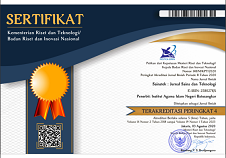PEMISAHAN ANION MENGGUNAKAN FASA DIAM HILIC IMIDAZOL PADA HYDROPHILIC INTERACTION LIQUID CHROMATOGRAPHY DENGAN PENAMBAHAN GARAM AMMONIUM ASETAT
Abstract
The need to detect anions and cations in a variety of environmental water samples more rapidly along with the increasing environmental problems and the time required analytical methods are precise, fast, simple and can provide an accurate assessment. Hydrophilic Interaction Liquid Chromatography (HILIC) is an extremely precise technique for separating polar compounds or compounds that are hydrophilic. The purpose of this study is to assess the separation of anions using HILIC stationary phases imidazole in hydrophilic interaction liquid chromatography with the addition of ammonium acetate salt. From the research that has been done can be concluded Imidazoles HILIC can separate SCN- anion, NO 3, NO 2, Br, and I- BrO3- using acetonitrile mobile phase. The addition of salt Ammonium Acetate in the mobile phase can increase the sensitivity and selectivity of anions. So that the resulting peak sharper and bigger.
Key words: HILIC Imidazol, anion, HILICFull Text:
PDF (Bahasa Indonesia)References
Albert, A.J. Hydrophilic-Interaction Chromatography for the Separation of Peptides, Nucleic Acids and Other Polar Compounds. J Chromatogr. 1990. 499. 177-196.
Alexander, L, N. Application of Hydrophilic Interaction Liquid Chromatography for the Analysis of Polar Contaminants in Food and Environmental Science. J. Chromatogr. 201
Alpert, Andrew J. Hydrophilic-interaction chromatography for the separation of peptides, nucleic acids and other polar compounds. J. Chromatogr. 1990. 499: 177–196.
Alpert, Andrew J. Electrostatic Repulsion Hydrophilic Interaction Chromatography for Isocratic Separation of Charged Solutes and Selective Isolation of Phosphopeptides. Anal. Chem. 2008. 80: 62–76.
Alpert, Andrew J. Peptide Orientation Affects Selectivity in Ion-Exchange Chromatography. Anal. Chem. 2010. 82: 5253– 5259
Braithwaite, A, Smith, F, J. Chromatographic Methods. Netherlands. 1999
Carrier, R, Bordanaro, J, Yip, K. Liquid Chromatography. 1997
Ding, W. Identification and Quantification of Glycoproteins Using Ion-Pairing Normal-Phase LC and MS. Molecular & Cellular Proteomics 2009. 8: 2170– 2185.
Eric S. Grumbach. Hydrophilic Interaction Chromatography Using Silica Columns for the Retention of Polar Analytes and Enhanced ESI-MS Sensitivity. 1999. LCGC Magazine.
Grimmet, M. Ross. Imidazole and Benzimidazole Synthesis. Academis Press
Guo Yong, Gaiki Shetal. Retention Behavior of Small Polar Compounds on Polar Stationary Phases in Hydrophilic Interaction Liquid Chromatography. J. Chromatogr. 2005. 71 – 80
Ikegami T. Separation Efficiencies in Hydrophilic Interaction Chromatography. J. Chromatogr. 2008. 1184. 474 – 503
Jandera, Pavel. Stationary Phases and Mobile Phases in Hydrophilic Liquid Chromatography. Analytica Chemica Acta 2011. 692. 11 -25
Michael, Cooke. Encyclopedia of Separation Science. USA
McKay, P. 2010. An Introduction to Chromatography.
Qiu, Hongdeng. Preparation and Evaluation of a Silica-based 1-alkyl-3(propyl-3-sulfonate) Imidazolium Zwitterionic Stationary Phases for High Performance Liquid Chromatography. J. Chromatogr. 2007. 1163. 63 – 69
Rees. 1984. Comprehensive Heterocyclic Chemistry. Vol 5. Page 469-498
Takeuchi T, Kawasaki T, Lim L. Separation of Inorganic Anions on a Pyridine Stationary Phase in Ion Chromatography. Analytical Science. 2010. Vol 26. 511 – 514Watson, G.D. The Hydrophilic Interaction Like Properties of Some Reversed Phase High Performance Liquid Chromatography Columns in The Analysis of Basic Compounds. J. Chromatogr. 2011. 1128. 1486 – 1491
Willey, John &Sons. 2004. Practical High Performace Liquid Chromatography. Fourth Edition. Switzerland
Yoshida, T. Peptide Separation in Normal Phase Liquid Chromatography. Analytical Chemistry. 1997. 69. 3038-3043.
Zein, R. Munaf, E. Takeuchi, T. Miwa, T. Application of microcolumnion chromatography using octadecylsilica immobilized with bovine serum albumin as stationary phase for the determination of inorganic anions. Journal of Abalitical Chemistry. 1996. 357 (4): 466 – 468.
DOI: http://dx.doi.org/10.31958/js.v7i2.136
Refbacks
- There are currently no refbacks.
Copyright (c) 2016 Dyna Putri Mayaserli

This work is licensed under a Creative Commons Attribution-NonCommercial-NoDerivatives 4.0 International License.
Indexed by:
__________________________________________________________________________
Sainstek: Jurnal Sains dan Teknologi
ISSN 2085-8019 (print) | 2580-278x (online)
Published by Institut Agama Islam Negeri Batusangkar
Email: sainstek@iainbatusangkar.ac.id
This work is licensed under a Creative Commons Attribution-NonCommercial-NoDerivatives 4.0 International License.















